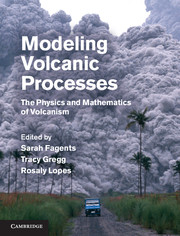Book contents
- Frontmatter
- Contents
- Contributors
- Chapter 1 Introduction
- Chapter 2 Magma chamber dynamics and thermodynamics
- Chapter 3 The dynamics of dike propagation
- Chapter 4 Dynamics of magma ascent in the volcanic conduit
- Chapter 5 Lava flows
- Chapter 6 Unsteady explosive activity
- Chapter 7 Unsteady explosive activity
- Chapter 8 Sustained explosive activity
- Chapter 9 Modeling tephra sedimentation from volcanic plumes
- Chapter 10 Pyroclastic density currents
- Chapter 11 Magma–water interactions
- Chapter 12 Deep-sea eruptions
- Chapter 13 Volcano–ice interactions
- Chapter 14 Modeling lahar behavior and hazards
- Chapter 15 Introduction to quantitative volcano seismology
- Chapter 16 Volcano acoustics
- Chapter 17 Planetary volcanism
- Index
- Plate section
- References
Chapter 8 - Sustained explosive activity
Volcanic eruption columns and hawaiian fountains
Published online by Cambridge University Press: 05 March 2013
- Frontmatter
- Contents
- Contributors
- Chapter 1 Introduction
- Chapter 2 Magma chamber dynamics and thermodynamics
- Chapter 3 The dynamics of dike propagation
- Chapter 4 Dynamics of magma ascent in the volcanic conduit
- Chapter 5 Lava flows
- Chapter 6 Unsteady explosive activity
- Chapter 7 Unsteady explosive activity
- Chapter 8 Sustained explosive activity
- Chapter 9 Modeling tephra sedimentation from volcanic plumes
- Chapter 10 Pyroclastic density currents
- Chapter 11 Magma–water interactions
- Chapter 12 Deep-sea eruptions
- Chapter 13 Volcano–ice interactions
- Chapter 14 Modeling lahar behavior and hazards
- Chapter 15 Introduction to quantitative volcano seismology
- Chapter 16 Volcano acoustics
- Chapter 17 Planetary volcanism
- Index
- Plate section
- References
Summary
Overview
This chapter reviews some of the physical processes responsible for the injection of large volumes of volcanic tephra and gas high into the atmosphere, following sustained explosive eruption from a volcanic vent. The resulting volcanic plumes or columns can disperse ash and aerosols over vast distances, and cause global perturbations to climate. In contrast, incandescent lava fountains are common manifestations of the low-intensity end of the spectrum of explosivity. This chapter presents a series of modeling approaches, from dimensional analysis to fully time-dependent, three-dimensional numerical treatments, in order to develop some quantitative understanding of these phenomena.
Introduction
When sustained explosive eruptions discharge tephra from a volcanic vent, the erupting material may form a convecting plume that rises high into the atmosphere; these flows are known as volcanic eruption columns (Fig. 8.1(a)). At moderate to high discharge rates subplinian and plinian columns rise to 10−40 km, penetrating the stratosphere, and erupt ejecta volumes of ~0.1 to ~10 km3, whereas very high ultraplinian discharges produce columns > 40−50 km high and erupt volumes of ≫ 10 km3. At low discharge rates, hawaiian activity (named after the archetypal eruption style of the Hawaiian basaltic volcanoes) erupts volumes of 104−108 m3 as incandescent lava fountains tens to hundreds of meters high (Fig. 8.1(b)), with weak plumes of fine pyroclasts rising above the fountains to heights of order 1−5 km.
- Type
- Chapter
- Information
- Modeling Volcanic ProcessesThe Physics and Mathematics of Volcanism, pp. 153 - 172Publisher: Cambridge University PressPrint publication year: 2013
References
- 2
- Cited by



